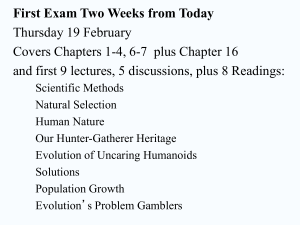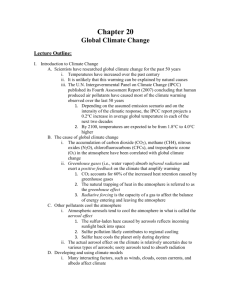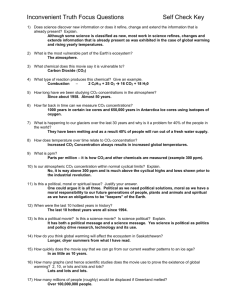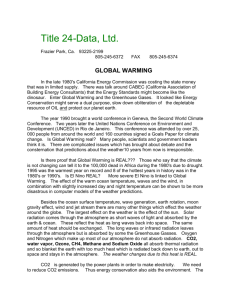attachment_id=793
advertisement
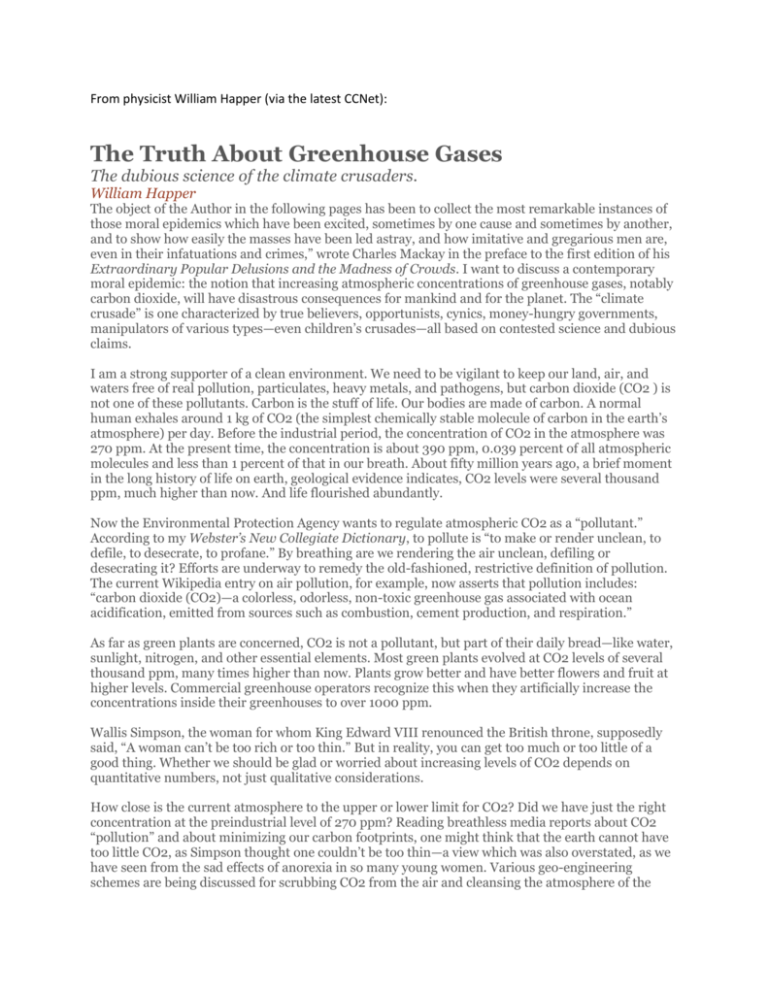
From physicist William Happer (via the latest CCNet): The Truth About Greenhouse Gases The dubious science of the climate crusaders. William Happer The object of the Author in the following pages has been to collect the most remarkable instances of those moral epidemics which have been excited, sometimes by one cause and sometimes by another, and to show how easily the masses have been led astray, and how imitative and gregarious men are, even in their infatuations and crimes,” wrote Charles Mackay in the preface to the first edition of his Extraordinary Popular Delusions and the Madness of Crowds. I want to discuss a contemporary moral epidemic: the notion that increasing atmospheric concentrations of greenhouse gases, notably carbon dioxide, will have disastrous consequences for mankind and for the planet. The “climate crusade” is one characterized by true believers, opportunists, cynics, money-hungry governments, manipulators of various types—even children’s crusades—all based on contested science and dubious claims. I am a strong supporter of a clean environment. We need to be vigilant to keep our land, air, and waters free of real pollution, particulates, heavy metals, and pathogens, but carbon dioxide (CO2 ) is not one of these pollutants. Carbon is the stuff of life. Our bodies are made of carbon. A normal human exhales around 1 kg of CO2 (the simplest chemically stable molecule of carbon in the earth’s atmosphere) per day. Before the industrial period, the concentration of CO2 in the atmosphere was 270 ppm. At the present time, the concentration is about 390 ppm, 0.039 percent of all atmospheric molecules and less than 1 percent of that in our breath. About fifty million years ago, a brief moment in the long history of life on earth, geological evidence indicates, CO2 levels were several thousand ppm, much higher than now. And life flourished abundantly. Now the Environmental Protection Agency wants to regulate atmospheric CO2 as a “pollutant.” According to my Webster’s New Collegiate Dictionary, to pollute is “to make or render unclean, to defile, to desecrate, to profane.” By breathing are we rendering the air unclean, defiling or desecrating it? Efforts are underway to remedy the old-fashioned, restrictive definition of pollution. The current Wikipedia entry on air pollution, for example, now asserts that pollution includes: “carbon dioxide (CO2)—a colorless, odorless, non-toxic greenhouse gas associated with ocean acidification, emitted from sources such as combustion, cement production, and respiration.” As far as green plants are concerned, CO2 is not a pollutant, but part of their daily bread—like water, sunlight, nitrogen, and other essential elements. Most green plants evolved at CO2 levels of several thousand ppm, many times higher than now. Plants grow better and have better flowers and fruit at higher levels. Commercial greenhouse operators recognize this when they artificially increase the concentrations inside their greenhouses to over 1000 ppm. Wallis Simpson, the woman for whom King Edward VIII renounced the British throne, supposedly said, “A woman can’t be too rich or too thin.” But in reality, you can get too much or too little of a good thing. Whether we should be glad or worried about increasing levels of CO2 depends on quantitative numbers, not just qualitative considerations. How close is the current atmosphere to the upper or lower limit for CO2? Did we have just the right concentration at the preindustrial level of 270 ppm? Reading breathless media reports about CO2 “pollution” and about minimizing our carbon footprints, one might think that the earth cannot have too little CO2, as Simpson thought one couldn’t be too thin—a view which was also overstated, as we have seen from the sad effects of anorexia in so many young women. Various geo-engineering schemes are being discussed for scrubbing CO2 from the air and cleansing the atmosphere of the “pollutant.” There is no lower limit for human beings, but there is for human life. We would be perfectly healthy in a world with little or no atmospheric CO2—except that we would have nothing to eat and a few other minor inconveniences, because most plants stop growing if the levels drop much below 150 ppm. If we want to continue to be fed and clothed by the products of green plants, we can have too little CO2. The minimum acceptable value for plants is not that much below the 270 ppm preindustrial value. It is possible that this is not enough, that we are better off with our current level, and would be better off with more still. There is evidence that California orange groves are about 30 percent more productive today than they were 150 years ago because of the increase of atmospheric CO2. Although human beings and many other animals would do well with no CO2 at all in the air, there is an upper limit that we can tolerate. Inhaling air with a concentration of a few percent, similar to the concentration of the air we exhale, hinders the diffusional exchange of CO2 between the blood and gas in the lung. Both the United States Navy (for submariners) and NASA (for astronauts) have performed extensive studies of human tolerance to CO2. As a result of these studies, the Navy recommends an upper limit of about 8000 ppm for cruises of ninety days, and NASA recommends an upper limit of 5000 ppm for missions of one thousand days, both assuming a total pressure of one atmosphere. Higher levels are acceptable for missions of only a few days. We conclude that atmospheric CO2 levels should be above 150 ppm to avoid harming green plants and below about 5000 ppm to avoid harming people. That is a very wide range, and our atmosphere is much closer to the lower end than to the upper end. The current rate of burning fossil fuels adds about 2 ppm per year to the atmosphere, so that getting from the current level to 1000 ppm would take about 300 years—and 1000 ppm is still less than what most plants would prefer, and much less than either the NASA or the Navy limit for human beings. Yet there are strident calls for immediately stopping further increases in CO2 levels and reducing the current level. As we have discussed, animals would not even notice a doubling of CO2 and plants would love it. The supposed reason for limiting it is to stop global warming—or, since the predicted warming has failed to be nearly as large as computer models forecast, to stop climate change. Climate change itself has been embarrassingly uneventful, so another rationale for reducing CO2 is now promoted: to stop the hypothetical increase of extreme climate events like hurricanes or tornados. But this does not necessarily follow. The frequency of extreme events has either not changed or has decreased in the 150 years that CO2 levels have increased from 270 to 390 ppm. Let me turn to some of the problems the non-pollutant CO2 is supposed to cause. More CO2 is supposed to cause flooded cities, parched agriculture, tropical diseases in Alaska, etc., and even an epidemic of kidney stones. It does indeed cause some warming of our planet, and we should thank Providence for that, because without the greenhouse warming of CO2 and its more potent partners, water vapor and clouds, the earth would be too cold to sustain its current abundance of life. Other things being equal, more CO2 will cause more warming. The question is how much warming, and whether the increased CO2 and the warming it causes will be good or bad for the planet. The argument starts something like this. CO2 levels have increased from about 280 ppm to 390 ppm over the past 150 years or so, and the earth has warmed by about 0.8 degree Celsius during that time. Therefore the warming is due to CO2. But correlation is not causation. Roosters crow every morning at sunrise, but that does not mean the rooster caused the sun to rise. The sun will still rise on Monday if you decide to have the rooster for Sunday dinner. There have been many warmings and coolings in the past when the CO2 levels did not change. A well-known example is the medieval warming, about the year 1000, when the Vikings settled Greenland (when it was green) and wine was exported from England. This warm period was followed by the “little ice age” when the Thames would frequently freeze over during the winter. There is no evidence for significant increase of CO2 in the medieval warm period, nor for a significant decrease at the time of the subsequent little ice age. Documented famines with millions of deaths occurred during the little ice age because the cold weather killed the crops. Since the end of the little ice age, the earth has been warming in fits and starts, and humanity’s quality of life has improved accordingly. A rare case of good correlation between CO2 levels and temperature is provided by ice-core records of the cycles of glacial and interglacial periods of the last million years of so. But these records show that changes in temperature preceded changes in CO2 levels, so that the levels were an effect of temperature changes. This was probably due to outgassing of CO2 from the warming oceans and the reverse effect when they cooled. The most recent continental ice sheets began to melt some twenty thousand years ago. During the “Younger Dryas” some 12,000 years ago, the earth very dramatically cooled and warmed by as much as 10 degrees Celsius in fifty years. The earth’s climate has always been changing. Our present global warming is not at all unusual by the standards of geological history, and it is probably benefiting the biosphere. Indeed, there is very little correlation between the estimates of CO2 and of the earth’s temperature over the past 550 million years (the “Phanerozoic” period). The message is clear that several factors must influence the earth’s temperature, and that while CO2 is one of these factors, it is seldom the dominant one. The other factors are not well understood. Plausible candidates are spontaneous variations of the complicated fluid flow patterns in the oceans and atmosphere of the earth—perhaps influenced by continental drift, volcanoes, variations of the earth’s orbital parameters (ellipticity, spin-axis orientation, etc.), asteroid and comet impacts, variations in the sun’s output (not only the visible radiation but the amount of ultraviolet light, and the solar wind with its magnetic field), variations in cosmic rays leading to variations in cloud cover, and other causes. The existence of the little ice age and the medieval warm period were an embarrassment to the global-warming establishment, because they showed that the current warming is almost indistinguishable from previous warmings and coolings that had nothing to do with burning fossil fuel. The organization charged with producing scientific support for the climate change crusade, the Intergovernmental Panel on Climate Change (IPCC), finally found a solution. They rewrote the climate history of the past 1000 years with the celebrated “hockey stick” temperature record. The first IPCC report, issued in 1990, showed both the medieval warm period and the little ice age very clearly. In the IPCC’s 2001 report was a graph that purported to show the earth’s mean temperature since the year 1000. A yet more extreme version of the hockey stick graph made the cover of the Fiftieth Anniversary Report of the United Nation’s World Meteorological Organization. To the surprise of everyone who knew about the strong evidence for the little ice age and the medieval climate optimum, the graph showed a nearly constant temperature from the year 1000 until about 150 years ago, when the temperature began to rise abruptly like the blade of a hockey stick. The inference was that this was due to the anthropogenic “pollutant” CO2. This damnatia memoriae of inconvenient facts was simply expunged from the 2001 IPCC report, much as Trotsky and Yezhov were removed from Stalin’s photographs by dark-room specialists in the later years of the dictator’s reign. There was no explanation of why both the medieval warm period and the little ice age, very clearly shown in the 1990 report, had simply disappeared eleven years later. The IPCC and its worshipful supporters did their best to promote the hockey-stick temperature curve. But as John Adams remarked, “Facts are stubborn things, and whatever may be our wishes, our inclinations, or the dictates of our passion, they cannot alter the state of facts and evidence.” The hockey-stick curve caught the attention of two Canadians, Steve McIntyre, a mining consultant, and an academic statistician, Ross McKitrick. As they began to look more carefully at the original data— much of it from tree rings—and at the analysis that led to the hockey stick, they became more and more puzzled. By hard, remarkably detailed, and persistent work over many years, consistently frustrated in their efforts to obtain original data and data-analysis methods, they showed that the hockey stick was not supported by observational data. An excellent, recent history of this episode is A. W. Montford’s The Hockey Stick Illusion. About the time of the Copenhagen Climate Conference in the fall of 2009, another nasty thing happened to the global-warming establishment. A Russian server released large numbers of e-mails and other files from computers of the Climate Research Unit (CRU) of the University of East Anglia. Among the files released were e-mails between members of the power structure of the climate crusade, “the team.” These files were, or should have been, very embarrassing to their senders and recipients. A senior scientist from CRU wrote, for example: “PS, I’m getting hassled by a couple of people to release the CRU station temperature data. Don’t any of you three tell anybody that the UK has a freedom of information act.” A traditional way to maintain integrity in science is through peer review, the anonymous examination of a scientific paper by qualified, competing scientists before publication. In a responsible peer review, the authors may be required to make substantial revisions to correct any flaws in the science or methodology before their paper is published. But peer review has largely failed in climate science. Global warming alarmists have something like Gadaffi’s initial air superiority over rag-tag opponents in Libya. Consider this comment from one of the most respected IPCC leaders, as revealed in the CRU e-mails: “I can’t see either of these papers being in the next IPCC report. Kevin and I will keep them out somehow—even if we have to define what the peer-review literature is.” And consider the CRU e-mail comment on a journal that committed the mortal sin of publishing one of the heretical papers: “I think we have to stop considering Climate Research as a legitimate peer-reviewed journal. Perhaps we should encourage our colleagues in the climate research community to no longer submit to, or cite papers in, this journal.” Peer review in climate science means that the “team” recommends publication of each other’s work, and tries to keep any off-message paper from being accepted for publication. James Madison reminds us in The Federalist Papers that “no man is allowed to be a judge in his own cause, because his interest would certainly bias his judgment, and, not improbably, corrupt his integrity. With equal, nay with greater reason, a body of men are unfit to be both judges and parties at the same time.” Madison goes on to observe that the smaller the community, the more likely that parties and judges will be one and the same. Let me summarize how the key issues appear to me, a working scientist with a better background than most in the physics of climate. CO2 really is a greenhouse gas and other things being equal, adding the gas to the atmosphere by burning coal, oil, and natural gas will modestly increase the surface temperature of the earth. Other things being equal, doubling the CO2 concentration, from our current 390 ppm to 780 ppm will directly cause about 1 degree Celsius in warming. At the current rate of CO2 increase in the atmosphere—about 2 ppm per year—it would take about 195 years to achieve this doubling. The combination of a slightly warmer earth and more CO2 will greatly increase the production of food, wood, fiber, and other products by green plants, so the increase will be good for the planet, and will easily outweigh any negative effects. Supposed calamities like the accelerated rise of sea level, ocean acidification, more extreme climate, tropical diseases near the poles, and so on are greatly exaggerated. “Mitigation” and control efforts that have been proposed will enrich a favored few with good political ties—at the expense of the great majority of mankind, including especially the poor and the citizens of developing nations. These efforts will make almost no change in earth’s temperature. Spain’s recent experiment with green energy destroyed several pre-existing jobs for every green job it created, and it nearly brought the country to bankruptcy. The frightening warnings that alarmists offer about the effects of doubling CO2 are based on computer models that assume that the direct warming effect of CO2 is multiplied by a large “feedback factor” from CO2-induced changes in water vapor and clouds, which supposedly contribute much more to the greenhouse warming of the earth than CO2. But there is observational evidence that the feedback factor is small and may even be negative. The models are not in good agreement with observations—even if they appear to fit the temperature rise over the last 150 years very well. Indeed, the computer programs that produce climate change models have been “tuned” to get the desired answer. The values of various parameters like clouds and the concentrations of anthropogenic aerosols are adjusted to get the best fit to observations. And—perhaps partly because of that—they have been unsuccessful in predicting future climate, even over periods as short as fifteen years. In fact, the real values of most parameters, and the physics of how they affect the earth’s climate, are in most cases only roughly known, too roughly to supply accurate enough data for computer predictions. In my judgment, and in that of many other scientists familiar with the issues, the main problem with models has been their treatment of clouds, changes of which probably have a much bigger effect on the temperature of the earth than changing levels of CO2. What, besides the bias toward a particular result, is wrong with the science? Scientific progress proceeds by the interplay of theory and observation. Theory explains observations and makes predictions about what will be observed in the future. Observations anchor our understanding and weed out the theories that don’t work. This has been the scientific method for more than three hundred years. Recently, the advent of the computer has made possible another branch of inquiry: computer simulation models. Properly used, computer models can enhance and speed up scientific progress. But they are not meant to replace theory and observation and to serve as an authority of their own. We know they fail in economics. All of the proposed controls that would have such a significant impact on the world’s economic future are based on computer models that are so complex and chaotic that many runs are needed before we can get an “average” answer. Yet the models have failed the simple scientific test of prediction. We don’t even have a theory for how accurate the models should be. There are many honest, hardworking climate scientists who are trying to understand the effects of CO2 on climate, but their work has fallen under suspicion because of the hockey-stick scandal and many other exaggerations about the dangers of increasing CO2. What has transformed climate science from a normal intellectual discipline to a matter of so much controversy? A major problem has been the co-opting of climate science by politics, ambition, greed, and what seems to be a hereditary human need for a righteous cause. What better cause than saving the planet? Especially if one can get ample, secure funding at the same time? Huge amounts of money are available from governments and wealthy foundations for climate institutes and for climaterelated research. Funding for climate studies is second only to funding for biological sciences. Large academic empires, prizes, elections to honorary societies, fellowships, and other perquisites go to those researchers whose results may help “save the planet.” Every day we read about some real or contrived environmental or ecological effect “proven” to arise from global warming. The total of such claimed effects now runs in the hundreds, all the alleged result of an unexceptional century-long warming of less than 1 degree Celsius. Government subsidies, loan guarantees, and captive customers go to green companies. Carbon-tax revenues flow to governments. As the great Russian poet Pushkin said in his novella Dubrovsky, “If there happens to be a trough, there will be pigs.” Any doubt about apocalyptic climate scenarios could remove many troughs. What about those who doubt the scientific basis of these claims, or who simply don’t like what is being done to the scientific method they were taught to apply and uphold? Publications of contrary research results in mainstream journals are rare. The occasional heretical article is the result of an inevitable, protracted battle with those who support the dogma and who have their hands on the scales of peer review. As mentioned above, we know from the Climategate emails that the team conspired to prevent contrary publications from seeing the light of day and even discussed getting rid of an editor who seemed to be inclined to admit such contentious material. Skeptics’ motives are publicly impugned; denigrating names are used routinely in media reports and the blogosphere; and we now see attempts to use the same tactics that Big Brother applied to the skeptical hero, Winston Smith, in Orwell’s 1984. In 2009 a conference of “ecopsychologists” was held at the University of West England to discuss the obvious psychological problems resident in those who do not adhere to the global warming dogma. The premise of these psychologists was that scientists and members of the general population who express objective doubt about the propagated view of global warming are suffering from a kind of mental illness. We know from the Soviet experience that a society can find it easy to consider dissidents to be mentally deranged and act accordingly. The management of most scientific societies has enthusiastically signed on to the global warming bandwagon. This is not surprising, since governments, as well as many states and foundations, generously fund those who reinforce their desired outcomes under the cover of saving the planet. Certain private industries are also involved: those positioned to profit from enacted controls as well as financial institutions heavily invested in “green technologies” whose rationale disappears the moment global warming is widely understood to be a non-problem. There are known connections and movements of people involved in government policy, scientific societies, and private industry, all with the common thread of influencing the outcome of a set of programs and investments underpinned by the supposed threat of global warming. My own trade union, the American Physical Society (APS), is a good example, but hardly the worst. An APS Council statement issued on November 18, 2007 states: “The evidence is incontrovertible: Global warming is occurring. If no mitigating actions are taken, significant disruptions in the Earth’s physical and ecological systems, social systems, security, and human health are likely to occur. We must reduce emissions of greenhouse gases beginning now.” This is pretty strong language for physicists, for whom skepticism about evidence was once considered a virtue, and nothing was incontrovertible. In the fall of 2009 a petition, organized by Fellow of the American Physical Society, Roger Cohen, and containing the signatures of hundreds of distinguished APS members was presented to the APS management with a request that at least the truly embarrassing word “incontrovertible” be taken out of the statement. The APS management’s response was to threaten the petitioners, while grudgingly appointing a committee to consider the request. It was exactly what James Madison warned against. The committee included members whose careers depended on global warming alarmism, and the predictable result was that not one word was changed. Bad as the actions of the APS were, they were far better than those of most other scientific societies, which refused to even reconsider extreme statements on climate. The situation is even more lamentable for the general public, which is fed a constant stream of propaganda by specialists in environmental issues from the mainstream media and well-funded alarmist blogs. Not unlike functionaries of Orwell’s Ministry of Truth in 1984, with its motto “Ignorance is Strength,” many members of the environmental news media dutifully and uncritically promote the party line of the climate crusade. However, the situation is slowly getting better. Skeptics are more numerous and better organized than before. In a few cases, leading former adherents have publicly and courageously spoken out against the dogma and its core of establishment promoters. The IPCC itself has come under severe criticism by the international scientific establishment for its series of bizarre errors and organizational failings. Under pressure from a dissident group of Fellows, the Royal Society moved to meaningfully moderate its former radically alarmist position on global warming. And perhaps most important of all, public skepticism has increased significantly, and with it has come a major drop in support of the climate crusade’s attempt to seize control of the “pollutant,” CO2. I began with a quotation from the preface of the first edition of Mackay’s Extraordinary Popular Delusions and the Madness of Crowds, and it is worth recalling now a quotation from the preface of the second edition: “Men, it has been well said, think in herds; it will be seen that they go mad in herds, while they only recover their senses slowly, one by one.” In our efforts to conserve the created world, we should not concentrate our efforts on CO2. We should instead focus on issues like damage to local landscapes and waterways by strip mining, inadequate cleanup, hazards to miners, and the release of real pollutants and poisons like mercury, other heavy metals, and organic carcinogens. Much of the potential harm from coal mining can be eliminated, for example, by requirements that land be restored to a condition that is at least as good as, and preferably better than, when the mining began. Life is about making decisions, and decisions are about trade-offs. We can choose to promote investment in technology that addresses real problems and scientific research that will let us cope with real problems more efficiently. Or we can be caught up in a crusade that seeks to suppress energy use, economic growth, and the benefits that come from the creation of national wealth. William Happer is the Cyrus Fogg Brackett Professor of Physics at Princeton University.


